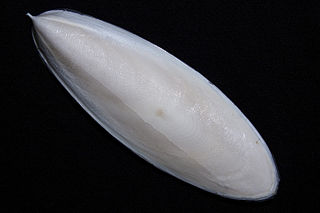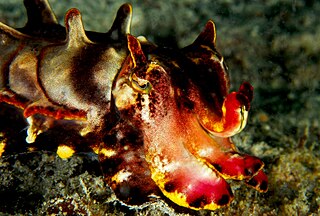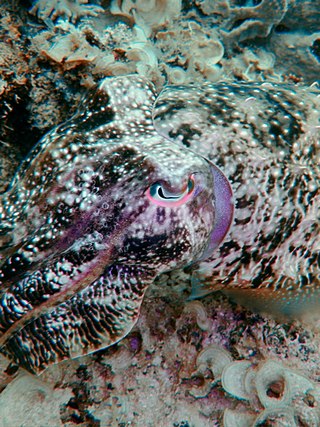
Cuttlebone, also known as cuttlefish bone, is a hard, brittle internal structure found in all members of the family Sepiidae, commonly known as cuttlefish, within the cephalopods. In other cephalopod families it is called a gladius.

Metasepia pfefferi, also known as the flamboyant cuttlefish, is a species of cuttlefish occurring in tropical Indo-Pacific waters off northern Australia, southern New Guinea, as well as numerous islands of the Philippines, Indonesia and Malaysia. The flesh of this colorful cephalopod contains unique acids, making it unsuitable for consumption.

Sepia latimanus, also known as the broadclub cuttlefish, is widely distributed from the Andaman Sea, east to Fiji, and south to northern Australia. It is the most common cuttlefish species on coral reefs, living at a depth of up to 30 m.

The common cuttlefish or European common cuttlefish is one of the largest and best-known cuttlefish species. They are a migratory species that spend the summer and spring inshore for spawning and then move to depths of 100 to 200m during autumn and winter. They grow to 49 cm in mantle length (ML) and 4 kg in weight. Animals from subtropical seas are smaller and rarely exceed 30 cm in ML.

Sepia mestus, also known as the reaper cuttlefish or red cuttlefish, is a species of cuttlefish native to the southwestern Pacific Ocean, specifically Escape Reef off Queensland to Murrays Beach off Jervis Bay. Reports of this species from China and Vietnam are now known to be misidentifications. S. mestus lives at a depth of between 0 and 22 m.

Sepia novaehollandiae is a species of cuttlefish native to the southern Indo-Pacific. Its natural range stretches from Shellharbour, New South Wales to North West Shelf in Western Australia. It lives at depths of between 15 and 348 m.
Sepia hedleyi, or Hedley's cuttlefish, is a species of cuttlefish in the family Sepiidae, endemic to subtropical and temperate waters off Australia.

Sepia tuberculata is a species of cuttlefish native to South African waters from Melkbosstrand to Knysna. It belongs to the genus Sepia. It lives in very shallow water to a depth of 3 m. It is endemic.
Sepia vermicularis, the patchwork cuttlefish.sometimes known as the common cuttlefish or ink-fish in South Africa, but the name common cuttlefish is more widely applied to Sepia officinalis. It is endemic to southern Africa.
Sepia zanzibarica, or the Zanzibar cuttlefish, is a species of cuttlefish native to the Indian Ocean.

Sepia prashadi, common name hooded cuttlefish, is a widely distributed species of cuttlefish. It has a thin, oval body and grows from 5 to 11 cm. The tips of the tentacles have a distinct club shape. S. prashadi is a migratory, demersal cuttlefish living in shallow waters at depths of approximately 40 to 50 metres. It is found in many locations including the east coast of Africa, around India, in the Red Sea, and Persian Gulf.
Sepia braggi, the slender cuttlefish, is a species of cuttlefish native to the Indo-Pacific Ocean. It has been found in coastal waters of southern Australia. This species was first collected in South Australia by its namesake, William Lawrence Bragg. Sepia braggi was then described by Sir Joseph Cooke Verco in 1907.Sepia braggi is part of the subgenus Doratosepion which contains to 41 species of cuttlefish in total.

Sepia elegans, the elegant cuttlefish, is a species of cuttlefish in the family Sepiidae from the eastern Atlantic Ocean and the Mediterranean Sea. It is an important species for fisheries in some parts of the Mediterranean where its population may have suffered from overfishing.
Sepia bertheloti, the African cuttlefish, is a species of cuttlefish from the family Sepiidae which is found in the warmer waters of the eastern Atlantic Ocean off Africa.

Sepia orbignyana, the pink cuttlefish, is a species of small cuttlefish from the family Sepiidae. It is occurs in the temperate and tropical waters of the eastern Atlantic Ocean.
Sepia hierredda, the giant African cuttlefish, is a species of cuttlefish from the family Sepiidae, which was previously considered conspecific with the common cuttlefish Sepia officinalis. It is found along the western coast of Africa and is an important species to fisheries.
Sepia cultrata, commonly known as the knifebone cuttlefish or elongated cuttlefish, is a species of cuttlefish from the family Sepiidae endemic to the southern Indo-Pacific. It is a deepwater species found in subtropical and temperate Australian waters.

Sepioloidea lineolata or more commonly known as the striped pyjama squid or the striped dumpling squid is a type of bottletail squid, that inhabits the Indo-Pacific Oceans of Australia. Although it is not quite a cuttlefish, as it does not have a cuttlebone, it is otherwise exactly the same as cuttlefish. Therefore it is a sepioid, not a real cuttlefish. However, it is usually referred to as a cuttlefish for public simplification. It is not a squid either. The striped pyjama squid lives on the seafloor and is both venomous and poisonous. When fully mature, a striped pyjama squid will only be about 7 to 8 centimeters in length. Baby striped pyjama squids can be smaller than 10mm.

Sepia lycidas, commonly known as the kisslip cuttlefish, is a species of cuttlefish within the genus Sepia. They are also classified under the family Sepiidae, which encompasses some of the most commonly known and recognized cuttlefish. Phylogenetically, this species of cuttlefish is most closely related to Sepia aculeata, Sepia esculenta, and Sepia pharaonis. This species is typically reddish brown to purple in color, with patches and stripes present on their dorsal mantle. On average, they grow to be about 38 cm in length and weigh 5 kg at maximum. The kisslip cuttlefish can be found mainly within the Indo-West Pacific, at depths ranging from 15–100 meters. Additionally, this species exhibits many diverse, complex reproductive behaviors; for example, courting, mating displays, and mate competition. Other interesting behaviors includes their feeding and hunting methods, which entails turning towards a preferred direction to "jump on" and engulf their prey of small fish and crustaceans. Sepia lycidas has many human uses and is important in the economy of many Southeast Asian countries, especially since they are often eaten for their high nutritional value. They are also currently being studied as an alternative source of collagen for human use, since their thick outer skin contain high levels of collagen that goes to waste when they are eaten or caught as bycatch.











